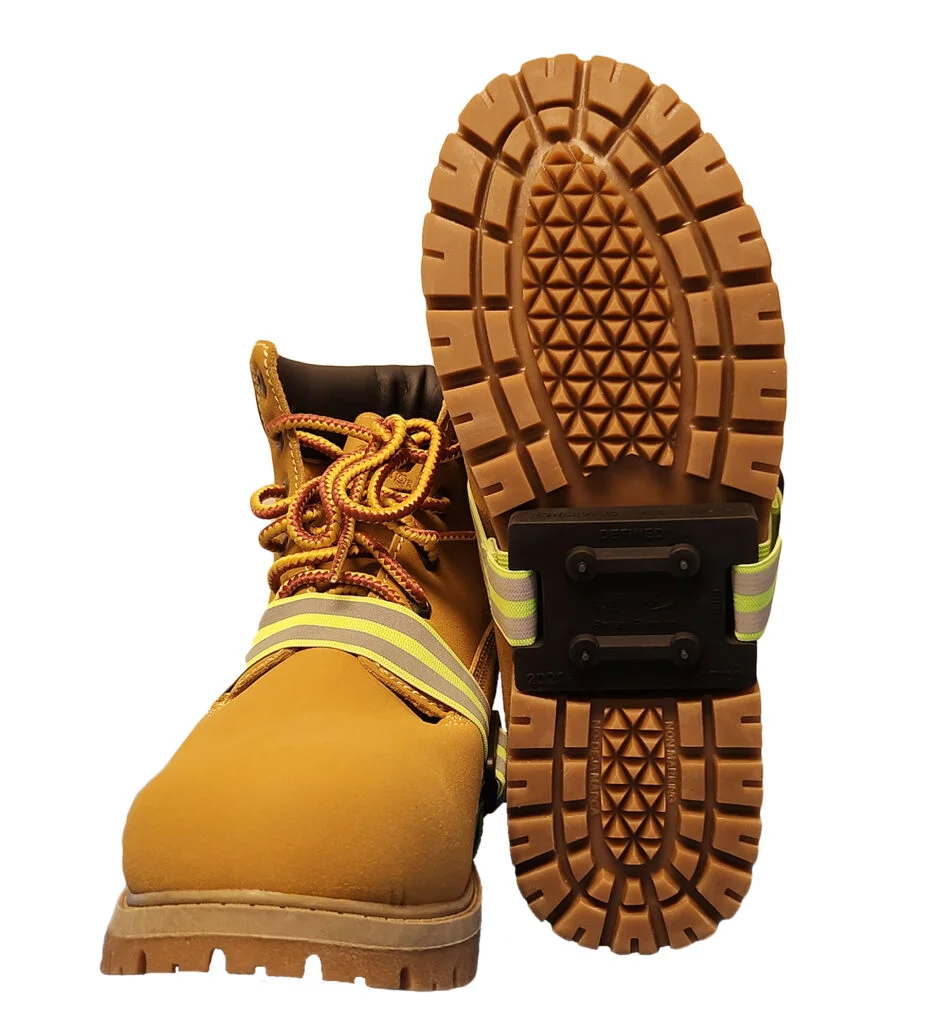According to the Canadian Institute of Health Information, there were 67,418 hospital emergency department visits in Canada due to unintentional falls on ice in 2019. Consider the magnitude of costs and losses caused by injuries from accidental slips and falls. The expenses associated with injuries of this type extend far beyond the medical treatment for both employees and companies.
Wearing and incorporating ice cleats, ice grips, or ice traction devices into your safety program is one of the easiest and most cost-effective ways to reduce the risk of falls caused by walking on icy or slippery surfaces.
When shopping for ice cleats, there are several factors to consider. To make things easier, we’ve put together the top 6 considerations when shopping for ice grips.
1. Keep Comfort in Mind When Selecting Your Ice Grips
Like any type of personal protective equipment (PPE), comfort is key. You want to make sure that the ice grips are comfortable underneath your foot and keep with your natural gait as much as possible. All too often, ice traction cleats can be big, bulky, and uncomfortable underfoot. Having something that adapts and integrates seamlessly with your footwear is important to maximize compliance, especially in the workplace where employee safety is a priority.
Footwear ice traction devices that use a rubbery compound that is soft and malleable underfoot provide the greatest level of comfort and performance. People buy safety footwear because they want to be comfortable on their feet all day. If you choose a traction device made of rigid plastic, it will cause soreness and discomfort, leading to poor compliance and an increased risk of slips and falls.
Make sure to select a size that fits comfortably over your shoes or boots and consider devices that are adjustable to fit a range of sizes. Not only should your ice grips fit comfortably, but they should also be easy to put on and take off, as well as store when not in use.
Avoid spring or coil designs
Avoid designs that have springs or coils, as these often do not provide consistent stability under your foot and depending on your direction of travel, may not offer the grip you’re looking for. Furthermore, as you wear ice traction devices with a steel coil design, the weight of the body will compress the coil underfoot and elongate the entire traction device, making it become sloppy and ill-fitting after minimal usage.
As you wear traction devices with a steel coil design, the weight of the body will compress the coil underfoot and elongate the entire traction device, making it become sloppy and ill-fitting after minimal usage. When walking on snowy surfaces the snow will collect inside the coil and ice up. This also creates a slip hazard when you transition to concrete or asphalt.
Opt for ice grips that maintain their shape and form throughout the life span of the product. Properly fitting ice traction cleats are critical to minimizing slips, trips, and falls.

2. Don’t Compromise When It Comes to the Traction of Your Ice Grips
The purpose of ice grips is to provide traction on slippery surfaces, so be sure you select ice grips that offer excellent grip on multiple surface types. In most industrial applications, you are going to be walking on a variety of surfaces such as asphalt, snow, concrete, ice, and metal grating, and perhaps even climbing onto machinery or ladders and scaffolding. You want to make sure that the traction device you select is designed to easily transition from one surface to another without being cumbersome or increasing risk.
Make sure your ice grips use tungsten carbide spikes

Ice grips that use tungsten carbide spikes offer several advantages over those that use rolled steel, including:
- Hardness – Tungsten carbide has greater hardness than rolled steel, making it much more resistant to wear and tear.
- Corrosion resistance – Tungsten carbide is highly resistant to corrosion, making it ideal for use in harsh environments, while rolled steel is suspectable to corrosion and requires special treatments or coatings.
- Strength – As it is much stronger than rolled steel, tungsten carbide can withstand higher stresses and loads.
- Precision – Tungsten carbide is very rigid and has excellent stability, allowing it to keep its shape and size even under extreme conditions.
Ice cleats or traction devices that use metal or steel cleats including spike design or screw type, will also cause a slip hazard. When the user walks on concrete, asphalt, or metal surfaces, it will case the metal material to round removing the original sharpness that provides the grip. When this happens, it is like walking on ice when walking on concrete or asphalt.
3. The Material Your Ice Grips Are Made from Matters
Selecting ice traction cleats made from high-quality, durable rubber is very important to make sure that your ice traction devices can withstand the most strenuous work environments, including freezing cold temperatures. Look for ice grips that are incredibly tough yet able to maintain their flexibility without cracking in extreme cold temperatures down to –40°C/-40ºF.
4. Consider the Design Type of Your Ice Grips
Ice grips typically come in three types of design: heel, mid-sole, and full sole. The design type you choose should depend on the intended application of the ice cleats.
- Heel Ice Grips
Heel ice grips are ideal for short-term exposure to outdoor winter conditions where you are moving in and out of buildings or vehicles. Look for traction devices that have heel pads that can easily slide to the back of the ankle when returning indoors or entering a vehicle.

- Mid-Sole Ice Grips
Mid-sole ice grips are ideal for short-term exposure to outdoor winter conditions where you are moving in and out of buildings or vehicles. It is important to find ice grips with a mid-sole pad that can easily be rotated to the top of the foot when stepping indoors or driving a vehicle. Also, because the a mid-sole design is positioned under the arch of the foot, you should select a product that is more comfortable underfoot. Many mid-sole products are made of a hard plastic material that cause great discomfort when standing or walking.

- Full Sole Ice Grips
Full sole designs are always best when walking long distances and for prolonged exposure to outdoor winter conditions. They stay in position while giving you traction on heel strike and when you are pushing off or pulling. Full sole ice grips are also the best solution for walking on sloped surfaces.

5. Additional Safety Concerns for Ice Grips
Given the huge array of different working environments and applications, it is important to select ice traction devices that will be safe in all environments.
Use products certified to NOT cause an ignition hazard
A large percentage of workers are in environments where flammability and risk of ignition are a major concern. It is crucial, when employees have workers working in these type of environments to select a product that is certified to not cause an ignition hazard.
Avoid steel studs or spikes because they can create a spark, especially when working on surfaces such as concrete, steel grating, and asphalt. If there are combustible materials nearby, this could result in an explosive catastrophe.
Avoid overly large spikes
It is important to note that you want to avoid designs with overly large traction spikes, as these can pose serious safety concerns and even unintentionally injure the wearer. Using an ice traction cleat with a spike design and pattern that will bite into ice and snow but still maintain contact with hard surfaces like concrete and asphalt is important to provide overall stability on a variety of walking surfaces.
Be mindful of any excess material
Many traction devices use bands, straps, or even elastics to keep the device on foot; however, this excess material, when tightened on your footwear, poses another tripping hazard. Ideally, ice traction devices should fit snugly on your footwear with no extra material dangling off.
Consider high-visibility features

Some traction devices incorporate features such as high-vis straps for safety, visibility, and to be seen by employers to aid in enforcing compliance by ensuring workers are wearing their PPE.
6. Make sure to consider Dentec’s ICETRED ice cleats
All ICETRED ice cleats use strategically positioned tungsten carbide spikes to offer excellent ice traction performance to help prevent workplace and recreational injuries.
Delivers Maximum Traction
- utstanding traction on ice and snow
- Most effective when moving on and off of icy surfaces
- Excellent traction on multiple surfaces including concrete and asphalt
- Uses strong tungsten carbide spikes for maximum traction
- Wears longer and holds its edge between than steel spikes
- Becomes sharper with more use and wear
- Have rubber traction studs for great traction on snow
Durable Design for Extreme Conditions
- Designed to withstand the harshest winter conditions
- Made from durable, natural rubber
- its flexibility without cracking in temperatures down to -40°C/-40ºF
Easy-to-Use and Comfortable
- Easily, comfortable, and securely fit over boots or shoes
- Lightweight and small enough to be easily stored
- Heel and mid-sole models easily slide or rotate off the sole when transitioning indoors or into a vehicle.
NOT a Spark Hazard!

ICETREAD™ ice cleats are third-party tested to NOT cause a spark on contact and can be used in gas groups A-D CSA C22.2 No. 213-17 combustibility testing protocol.
Multiple Designs to Choose From
ICETRED™ ice cleats come in three models: heel ice cleats, mid-sole ice cleats, and full sole ice cleats.
Heel Ice Cleats – Ideal for short-term exposure to winter conditions and when frequently moving in and out of buildings or vehicles. The heel pad easily slides to the back of the ankle when not in use.

Heel
Mid-Sole Ice Cleats – Also ideal for short-term exposure and when often moving in and out of buildings or vehicles. They come in two different thicknesses for footwear with either a non-defined heel or a more defined heel. The mid-sole pad easily rotates to the top of the foot when not in use. It features an adjustable, lime-green, high-visibility retro-reflective strap.

Full Sole Ice Cleats – Ideal for walking long distances and prolonged exposure to winter conditions. They stay in position to give you traction on heel strikes and when pushing off. They are the best solution for walking on sloped surfaces.

Prevent Workplace and Recreational Injuries
Ice grips are designed to prevent injuries caused by accidental slips and falls in icy or slippery conditions. They can be an easy and cost-effective solution. In just seconds, you can transform your ordinary, everyday boots or shoes into ice traction devices that offer you maximum traction.
However, all ice grips or ice cleats are not created equal. Use the above top 6 considerations as a guide when shopping for your next pair of ice grips. When it comes to your safety or the safety of your workers, there’s no reason to compromise.









